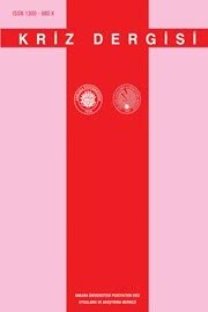DEPREMZEDE AİLELERE YÖNELİK KORUYUCU MÜDAHALE ÇALIŞMASI
Amaç: Bu araştırmanın amacı doğal afetler sonrasında zarar gören aileleri daha sonra ortaya çıkabilecek aile işlevi sorunlarından ve bireylerini psikiyatrik hastalıklardan koruyabilecek ve erken dönemdeki sorunlarını giderebilecek, aile temelli, yapılandırılmış bir müdahale modeli oluşturulmasıdır. Yöntem: Bu araştırma prospektif bir müdahale çalışmasıdır. Bolu İli'ndeki ispanyol Çadırkenti'nde yaşayan ve buradan sistematik örneklem ile seçilen 77 aileye, aile temelli koruyucu bir müdahale çalışması uygulanmıştır. Araştırmaya katılmayı kabul eden ailelerde yer alan 281 aile bireyi ile ilgili bilgi toplanmıştır. Ruhsal sorunları değerlendirmede 6-14 yaş grubunda Çocuk Depresyon Ölçeği (ÇDÖ), Çocuk Travma Sonrası Stres Reaksiyonu Tepki İndeksi (ÇTSS-RI), Spielberger Çocuklar İçin Durumluk ve Sürekli Kaygı Ölçeği (ÇDSKDÖ) kullanılmıştır. 15 yaş üstü grubun değerlendirilmesinde ise Beck Depresyon Ölçeği (BDÖ), Genel Sağlık Anketi (GSA), Çok Boyutlu Algılanan Sosyal Destek Ölçeği (ÇBASD) ve Travma Sonrası Stres Bozukluğu Kısa Tanı Ölçeği (TSSB-KTÖ) kullanılmıştır. Bu görüşmeler sırasında işlevlerinde bozukluk saptanan aileler ve herhangi bir psikiyatrik hastalık saptanan bireyler tedaviye alınmışlardır. Bulgular: Araştırmaya 145'i erkek, 136'sı kadın cinsiyetinde yaşları 0-82 arasında değişen (ortalama 24.93±17.40) 281 aile bireyi katılmıştır. 6-14 yaş grubundaki bireylerin % 16.7'sinde depresyon, % 18.8' inde ağır, % 52.1'inde orta düzeyde TSSB belirtileri saptanmıştır. 15 yaş ve üzerindeki bireylerin ise % 44.0'ında depresyon, % 36.3'ünde TSSB tespit edilmiştir. Sonuç: Bu çalışma sonuçları büyük felaketler sonrasında kliniğe başvurmayan kişilerde de psikopatoloji oranının yüksek olduğunu göstermesi açısından literatürdeki diğer çalışmalarla uygunluk içindedir. Bu durum bu tür travmalarla karşılaşan ailelere ruhsal destek sağlamanın koruyucu psikiyatri açısından önemini ortaya koymaktadır
Anahtar Kelimeler:
Travma sonrası stres bozukluğu, travma, deprem, aile ruh sağlığı
A Preventive Family Intervention for Earthquake Survivors
Objective: The aim of this study is to provide a semi-structured intervention model for families who have experienced Bolu earthquake to prevent family dysfunction and psychiatric problems in family members due to traumatic effects of earthquake. Method: 77 families from Bolu Spanish tent-city were chosen by random sampling method and were seen in their tents by members of the research team, for assessment and family therapy session. Data were collected from 281 individual members of these families. Assessment of children aged between 6-14 was done using Child Depression Inventory (CDI), Children's post-traumatic response reaction index (CPTS-RI), State-Trait Anxiety Inventory for Children (STAI-C); adolescents and adults were assessed using: general health questionnaire (GHQ), Beck Depression Inventory (BDI), Multidimensional Scale of Perceived Social Support (MSPSS) and PTSD brief diagnostic scale (PTSD-BDS). Results: 145 males and 136 females aged between 0-82 (mean: 24.9) who were the members of 77 families were assessed for this study. İn 6-14 age group 16.7 % showed depression, 18.8 % severe and 52.1 % moderate levels of PTSD signs as assessed by questionnaires. For the adolescent and adult members of the families that were above age 14, depression rate was 44.0 % and PTSD rate was 36.3 %. Conclusions: The results of this study supports previous studies in the literatüre that have found high levels of psychopathology in survivors of majör disasters even in non-clinical populations. This finding shows the necessity of the development of preventive approaches to maintain the mental health of earthquake survivors.
Keywords:
Post traumatic stress disorder trauma, disaster survivors, earthquake, family mental health,
___
- Armenian HK, Morikavva M, Melkonian AK, Hovanesian AP, Haroutunian N, Saigh PA, Akiskal K, Akiskal HS (2000) Loss as a determinant of TSSH in a cohort of adult survivors of the 1988 earthquake in Armenia: implicationsfor policy. Açta Psychiatr Scand, 102:58-64.
- Başoğlu M, Şalcıoğlu E (2001) Traumatic stress response in survivors of earthquake in Turkey. J Trauma Stress (baskıda).
- Beck AT, Ward CH, Mendelson M ve ark (1961) An inventory for measuring depression. Arch Gen Psychiatry,4:561-571.
- Bramsen I, Dirkzvvager AJE, van der Ploeg HM (2000) Predeployment personality traits and exposure to trauma as predictors of posttraumatic stress symptoms: a prospective study of former peacekeepers. A J Psychiatry, 157:1115-1119.
- Bulut I (1990) Aile Değerlendirme Ölçeği El Kitabı. Özgüzeliş Matbabası, Ankara.
- Çakır Y, Palabıyıkoğlu R (1997) Gençlerde sosyal destek- Çok Boyutlu Algılanan Sosyal Destek Ölçeğinin güvenirlik ve geçerlik çalışması. Kriz Dergisi, 5(1 ):15-24.
- Carlier İVE, Lamberts RD, Van Uchelen AJ, Gersons BPR (1998) Clinical utility of a Brief Diagnostic Test for posttraumatic stress disorder. Psychosomatic Medicine, 60:42-47.
- Carr VJ, Levvin TJ, VVebster RA, Hazell PL, Kenardy JA, Carter GL (1995) Psychosocial sequeae of the 1989 Nevvcastle earthquake: I. Community disaster experiences and psyhological morbidity 6 months postdisaster. Pychol Med, 25: 539-55
- ISSN: 1300-980X
- Başlangıç: 1992
- Yayıncı: Ankara Üniversitesi
Sayıdaki Diğer Makaleler
ANNE VE BABA GÖZÜYLE "ÇOCUK EĞİTİMİ" BİR SOSYAL TEMSİL ÖN ÇALIŞMASI
ANNE VE BABA GÖZÜYLE "ÇOCUK EĞİTİMİ" BİR SOSYAL TEMSİL ÖN ÇALIŞMASI
PSİKİYATRİ POLİKLİNİĞİNE BAŞVURAN HASTALARDA NİKOTİN BAĞIMLILIĞI
Murat KULOĞLU, Murad ATMACA, Aytaç POLAT S., Ahmet ÜNAL, Ertan TEZCAN A.
DEPREMZEDE RUHSAL DANIŞMA MERKEZİNE BAŞVURANLARIN SOSYODEMOGRAFİK ÖZELLİKLERİ VE SEMPTOM SIKLIKLARI
Nahit Kamil ÖZMENLER, Tunay KARLIDERE, Salih BATTAL
THE EPİDEMIOLOGY OF SUICIDE ATTEMPTS İN EUROPE
DEPREMZEDE AİLELERE YÖNELİK KORUYUCU MÜDAHALE ÇALIŞMASI
İşık SAYIL, Saynur CANAT, Recep AKDUR, Öztürk KILIÇ EMİNE, Rana USLU
HABER / 36. ULUSAL PSİKİYATRİ KONGRESİ ANTALYA/ BELEKTE GERÇEKLEŞTİRİLDİ
